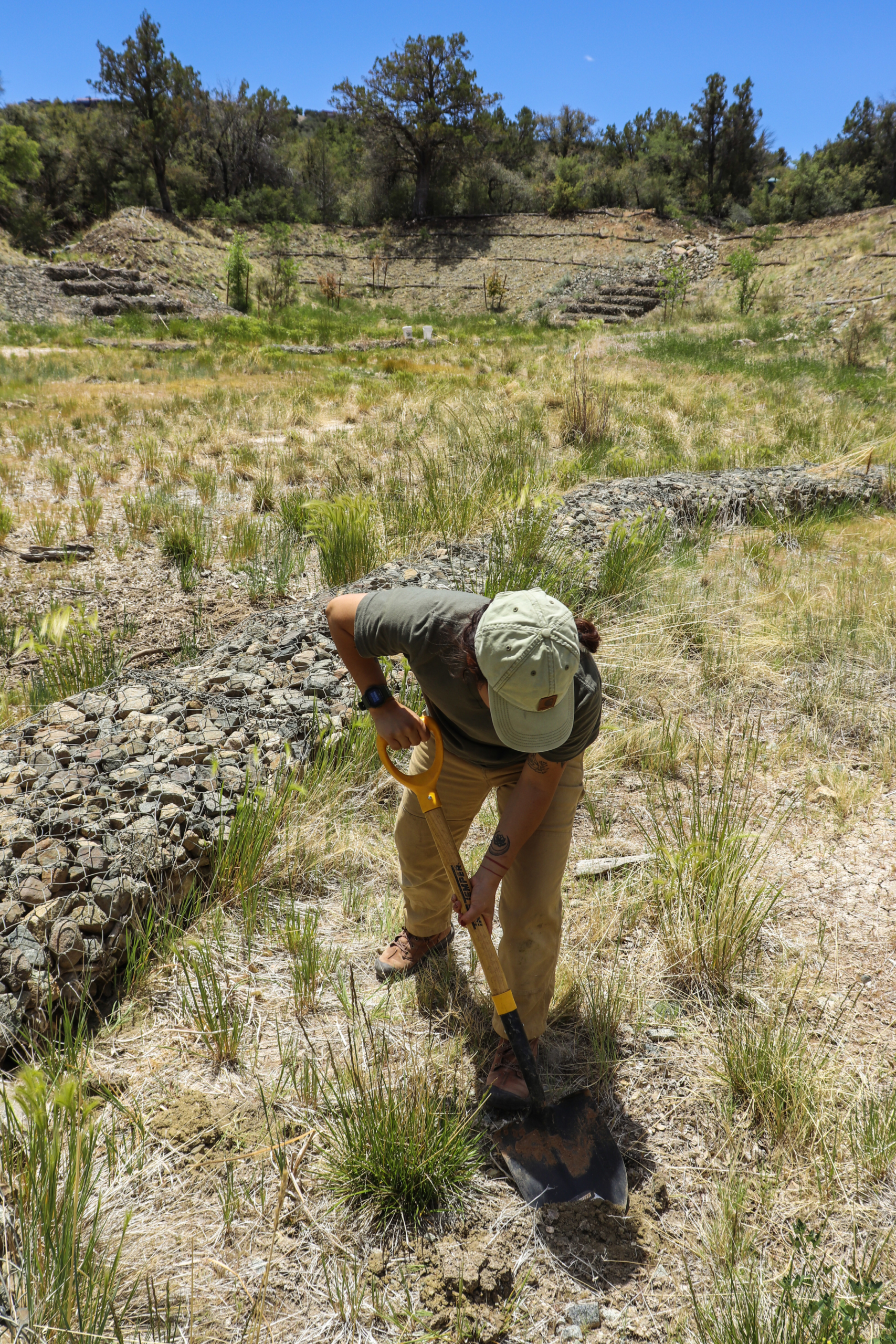
Arizona is one of the driest states in the country. Water is precious here. This makes the watershed improvement projects completed by GEM Environmental Corps all the more important.
Based in Prescott, AZ, the GEM Corps team was introduced to watershed restoration work in the spring of 2021 when they participated in the annual Granite Creek cleanup hosted by Prescott Creeks, a local nonprofit. The GEM Corps AmeriCorps members contributed to pulling upwards of three tons of waste from Granite Creek and surrounding lands. Since then, GEM Corps has partnered with Prescott Creeks on subsequent projects at Watson Woods Riparian Preserve, a critical habitat area managed by Prescott Creeks.

The team has focused on removing invasive species from the preserve, including common teasel, vinca, and Siberian elm. According to Jake Morris, an AmeriCorps member and the GEM Corps Crew Leader, Siberian elm is of particular concern.
“Back in the Dust Bowl era, they planted it to retain the soil because it does really well in droughts. Because of that, however, it’s spread rapidly throughout the Southwest and it’s out-competing local vegetation…It’s destroying habitat that the local wildlife is used to,” said Jake.
AmeriCorps member Steph Garcia-Hernandez expanded on the need for this work.
“This work is important because the more we learn about riparian ecosystems and all the factors necessary to have a healthy riparian area, the better equipped we are with this information to advocate for these areas and educate others.”

Along with fellow GEM Corps AmeriCorps members Steph and Tenzin Choeden, Jake has helped lead the removal of many undesirable trees from the preserve. This can be a challenge for a small crew.
“I was thinking, ‘Oh we’ll be able to cut down tons of trees! It’ll be great!’ – but one tree is a project in itself,” said Jake.
In addition to their work with Prescott Creeks, GEM Corps also does watershed restoration projects in partnership with Yavapai County Public Works. Among other efforts, this work involves removing Siberian elms and helping create a more diverse, native plant population within Prescott’s green infrastructure.

“The green infrastructure includes vegetated areas within an urban environment. These spaces are really important not just in the urban environment, but outside it, too; there’s a lot of runoff that comes from the urban environment. These spaces are a barrier between what’s being produced by the urban environment and the local ecosystem,” said Jake.
The GEM Corps team has visited healthy green infrastructure sites to collect seed samples from numerous plants, including cattail, vine mesquite, and Apache plume. They then spread the seeds throughout more barren spots. While the ground is extremely dry now (the region is experiencing a multi-year drought), the team tries to envision where water will flow when the rain comes in the late summer and early fall.
 “It’s really cathartic spreading seeds,” said Jake. “You’re digging and putting your hands in the soil and putting these seeds in the soil and covering them up. That’s really nice.”
“It’s really cathartic spreading seeds,” said Jake. “You’re digging and putting your hands in the soil and putting these seeds in the soil and covering them up. That’s really nice.”
In addition, the team has worked with the county to create one rock dams in channels to help slow waterflow, control erosion and flooding, and promote sedimentation.
These projects have an important effect downstream. Watson Lake, a manmade reservoir in Prescott, has experienced spikes in nutrient levels and E. Coli due to runoff. Granite Creek also leads to the critical Verde River, one of the few still existing perennial waterways in Arizona. The AmeriCorps members’ service is rewarding, but it’s not without its challenges.
“We were in New Mexico, and we saw tons of Siberian elms – and not only Siberian elms growing like weeds out of the cement. They had been intentionally planted in court squares,” said Jake. “We’re trying to eradicate them in one space, but then they’re being used as ornamental pieces in other spaces. That’s a thing to struggle with.”
AmeriCorps member Steph Garcia-Hernandez expressed the same frustration.
“I enjoy using the chainsaw to remove Siberian elms, but it is also challenging work because this species seems to be out of control and out of our reach no matter our efforts to remove it.”
Through their service terms, the GEM Corps participants have undergone chainsaw training and they each earned a watershed management certificate. They have also learned a lot about teamwork.
 “Some of the skills I have used throughout this experience are problem-solving, interpersonal skills, attention to detail, and time management,” said AmeriCorps member Tenzin Choeden. “I learned the importance of building professional relationships with different organizations that we work with and staying connected for future collaborations…[I have enjoyed] working with different organizations and getting in-depth exposure to different management roles.”
“Some of the skills I have used throughout this experience are problem-solving, interpersonal skills, attention to detail, and time management,” said AmeriCorps member Tenzin Choeden. “I learned the importance of building professional relationships with different organizations that we work with and staying connected for future collaborations…[I have enjoyed] working with different organizations and getting in-depth exposure to different management roles.”
Looking to the future, the GEM Corps team is helping lead a fuel mitigation and wildfire prevention discussion for children in collaboration with the Yavapai Apache Nation and Prescott Creeks. They also hope to get involved in water quality testing and potentially more intensive green infrastructure planning and construction. As Tenzin said, all of this work is part of a bigger picture.
“We need more young leaders to work with different environmental organizations throughout the country to achieve equal access to outdoor recreation for everyone, regardless of race, sex, gender, and socio-economic background.”


































































